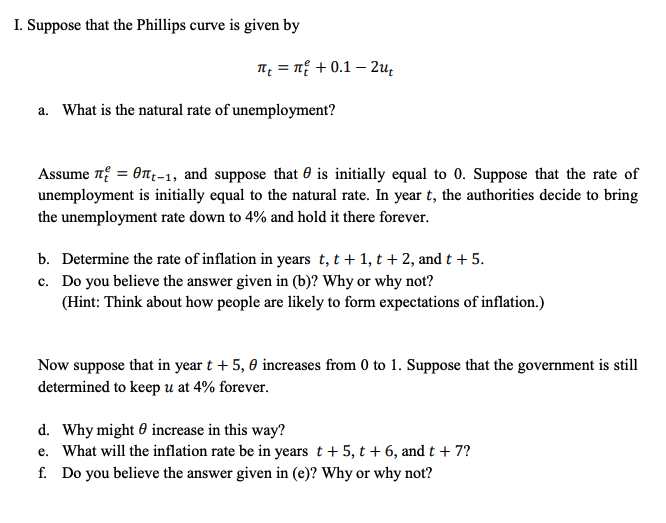I. Suppose that the Phillips curve is given by 1 = n + 0.1 – 2u; a. What is the natural rate of unemployment? Assume 7 = On;-1, and suppose that 0 is initially equal to 0. Suppose that the rate of unemployment is initially equal to the natural rate. In year t, the authorities decide to bring the unemployment rate down to 4% and hold it there forever. b. Determine the rate of inflation in years t, t + 1, t + 2, and t + 5. c. Do you believe the answer given in (b)? Why or why not? (Hint: Think about how people are likely to form expectations of inflation.)
I. Suppose that the Phillips curve is given by 1 = n + 0.1 – 2u; a. What is the natural rate of unemployment? Assume 7 = On;-1, and suppose that 0 is initially equal to 0. Suppose that the rate of unemployment is initially equal to the natural rate. In year t, the authorities decide to bring the unemployment rate down to 4% and hold it there forever. b. Determine the rate of inflation in years t, t + 1, t + 2, and t + 5. c. Do you believe the answer given in (b)? Why or why not? (Hint: Think about how people are likely to form expectations of inflation.)
Chapter10: Aggregate Supply
Section: Chapter Questions
Problem 1.1P
Related questions
Question
a, b, c

Transcribed Image Text:I. Suppose that the Phillips curve is given by
1 = n + 0.1 – 2u;
a. What is the natural rate of unemployment?
Assume 7 = On;-1, and suppose that 0 is initially equal to 0. Suppose that the rate of
unemployment is initially equal to the natural rate. In year t, the authorities decide to bring
the unemployment rate down to 4% and hold it there forever.
b. Determine the rate of inflation in years t, t + 1, t + 2, and t + 5.
c. Do you believe the answer given in (b)? Why or why not?
(Hint: Think about how people are likely to form expectations of inflation.)
Now suppose that in year t + 5, 0 increases from 0 to 1. Suppose that the government is still
determined to keep u at 4% forever.
d. Why might 0 increase in this way?
e. What will the inflation rate be in years t + 5, t + 6, and t + 7?
f. Do you believe the answer given in (e)? Why or why not?
Expert Solution
This question has been solved!
Explore an expertly crafted, step-by-step solution for a thorough understanding of key concepts.
Step by step
Solved in 2 steps with 2 images

Knowledge Booster
Learn more about
Need a deep-dive on the concept behind this application? Look no further. Learn more about this topic, economics and related others by exploring similar questions and additional content below.Recommended textbooks for you


Brief Principles of Macroeconomics (MindTap Cours…
Economics
ISBN:
9781337091985
Author:
N. Gregory Mankiw
Publisher:
Cengage Learning

Essentials of Economics (MindTap Course List)
Economics
ISBN:
9781337091992
Author:
N. Gregory Mankiw
Publisher:
Cengage Learning


Brief Principles of Macroeconomics (MindTap Cours…
Economics
ISBN:
9781337091985
Author:
N. Gregory Mankiw
Publisher:
Cengage Learning

Essentials of Economics (MindTap Course List)
Economics
ISBN:
9781337091992
Author:
N. Gregory Mankiw
Publisher:
Cengage Learning

Principles of Economics 2e
Economics
ISBN:
9781947172364
Author:
Steven A. Greenlaw; David Shapiro
Publisher:
OpenStax